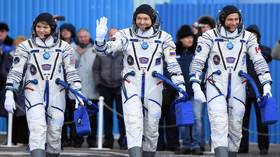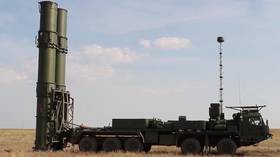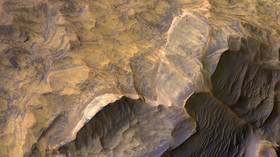Poekhali! Russian spaceship named after Yuri Gagarin blasts off almost sixty years after Soviet cosmonaut’s record-smashing flight
A Russian-made Soyuz rocket has lifted off from a cosmodrome in the Kazakh desert. It will now carry its crew – two Russians and one American – to the International Space Station, orbiting more than 400km above the Earth.
The spacecraft is expected to dock on its base on Friday, within hours of the launch, where the astronaut and cosmonauts will stay for 191 days in order to carry out dozens of scientific experiments and conduct at least two spacewalks.
The manned capsule carrying the team is named after Yuri Gagarin, who made history on April 12, 1961, when he became the first person to orbit the Earth. The 60th anniversary of that event will be celebrated on Monday. The Soviet pilot’s iconic flight inspired a generation to imagine the possibilities of space travel, and cemented the USSR’s status as a technological superpower.
Also on rt.com American astronauts to again use Russian Soyuz rocket to reach ISS as NASA can’t rely on ‘unstable’ US tech – Moscow space chiefKazakhstan’s Baikonur Cosmodrome, from which Friday’s mission began, was the same location used to launch Gagarin’s Vostok 1 spacecraft, and symbols commemorating the date are plastered across the spaceship.
In March, the chief of Russia’s space agency, Roscosmos, said the US’ reliance on Moscow’s rockets to ferry its astronauts to and from the International Space Station was proof that new American spaceflight is still “unstable.” Since 2011, Washington had relied on Roscosmos for manned missions, having scrapped its own shuttle program.
However, in May last year, Elon Musk’s SpaceX became the first private company to operate on the high-altitude route, landing two Americans on the orbital base. Nevertheless, despite the feat, the US is still reliant on Russia for regular missions.
Moscow and Washington announced last week that they had signed an agreement to renew the decades-old partnership, and affirmed their commitment to work together in the name of “the exploration and the use of outer space for peaceful purposes.” First signed in 1992 between then-president George W. Bush and Russia’s first post-Soviet leader, Boris Yeltsin, the pact underwrites co-operation between the two nations for the coming decade.
A fortnight ago, another Soyuz rocket blasted off, carrying 36 satellites into low-Earth orbit, as part of a joint effort with UK firm OneWeb to create an artificial “constellation” that will help expand internet coverage across the globe.
Think your friends would be interested? Share this story!















